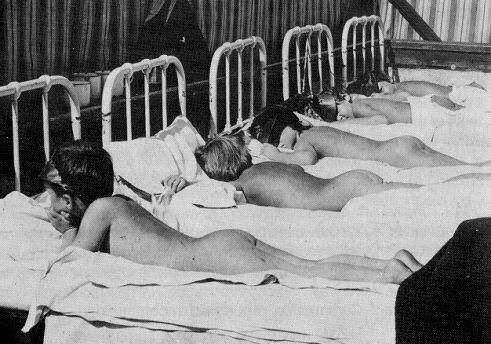
Sanitoria Country Trends: Canada

Figure 1.--Here we have a photograph from the Prince Albert Sanatorium in Saskatchewa. The photo was taken in 1955. By that time as a result of the introduction of antibiotics, many sanatoria began to close. Antibiotics were much more effective way of treating tuberculosis.
|
|
Sir William Gage helped found the National Sanatorium Association (NSA) to promote Canadian snitoria to treat tunberclosis. The first Canadian sanatorium was opened at Muskoka Lake, Ontario (1897). Ontario and neighbiring Quebec are the most populace Canadian provinces. The Muskoka facility was similar to the sanitoria being opened to the south in the United States rather than the mountain sites used in Switzerlad. The NSA opened two more sanatoriums in Ontario during the 1900s. The NSA did not succeed in founding many sanatoria in other province, but the work in Ontario brought the need for similar facilities to the attention of authorities in other provinces. Eventually therecould be sanitoria located throughoutvthe country. Authorities open a small (eight bed) Highland View Sanatorium in Nova Scotia (1899) and replaced byy the 18 bed Kentville Sanatorium (1904). Sir William and the NSA opened the Toronto Free Hospital for Consumptive Poor (1904). Thec city donated used horse-drawn street-cars to the City for use as patient pavilions. Subsequent sanatora included: King Edward San in Tranquille, British Colombia (1907); Laurentian San in St. Agathe, Quebec (1908), Ninette San in Manitoba (1910); Jordan Memorial San at River Glade, New Brunswick (1913), Dalton San in Charlottetown (1915), Fort Qu’Appelle San in Saskatchewan (1917), St. Johns San in Newfoundland (1917), and Bowness San in Calgary (1920). Canada is a veryblarge country. There were mountains in the West that could emulate the Swiss sanatoria. Canadian authoritie, hweve, decided tht it was more imporant to have sanatoria near the population centers. And they could also benefit by being close to hospitals with medical supplies and doctors. Canada eventually built an extensive national network of sanitoria, many operated by provinicial/municipal authorities. As in other countries, the development of antibiotics meant that after World War II, these facilities began to close, but we see some operating into the 1960s.
HBC

Navigate the Historic Boys' Clothing Web Site:
[Return to Main sanitoria country page]
[Return to Main sanitoria page]
[Return to Main children's health institutions]
[Return to Main institutional page]
[Return to Main Canadian page]
[Introduction]
[Activities]
[Biographies]
[Chronology]
[Clothing styles]
[Countries]
[Bibliographies]
[Contributions]
[FAQs]
[Glossary]
[Images]
[Links]
[Registration]
[Tools]
[Boys' Clothing Home]
Created: 7:00 AM 4/12/2012
Last update: 7:00 AM 4/12/2012



